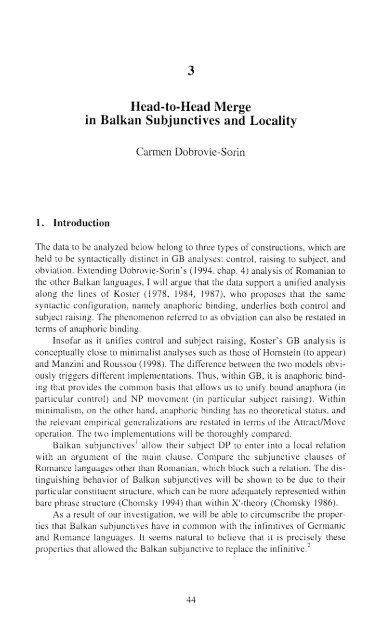Comparative Syntax of the Balkan Languages (Oxford ... - Cryptm.org
Comparative Syntax of the Balkan Languages (Oxford ... - Cryptm.org
Comparative Syntax of the Balkan Languages (Oxford ... - Cryptm.org
- No tags were found...
You also want an ePaper? Increase the reach of your titles
YUMPU automatically turns print PDFs into web optimized ePapers that Google loves.
3Head-to-Head Mergein <strong>Balkan</strong> Subjunctives and LocalityCarmen Dobrovie-Sorin1. IntroductionThe data to be analyzed below belong to three types <strong>of</strong> constructions, which areheld to be syntactically distinct in GB analyses: control, raising to subject, andobviation. Extending Dobrovie-Sorin's (1994. chap. 4) analysis <strong>of</strong> Romanian to<strong>the</strong> o<strong>the</strong>r <strong>Balkan</strong> languages, I will argue that <strong>the</strong> data support a unified analysisalong <strong>the</strong> lines <strong>of</strong> Koster (1978, 1984, 1987), who proposes that <strong>the</strong> samesyntactic configuration, namely anaphoric binding, underlies both control andsubject raising. The phenomenon referred to as obviation can also be restated interms <strong>of</strong> anaphoric binding.Ins<strong>of</strong>ar as it unifies control and subject raising, Koster's GB analysis isconceptually close to minimalist analyses such as those <strong>of</strong> Hornstein (to appear)and Manzini and Roussou (1998). The difference between <strong>the</strong> two models obviouslytriggers different implementations. Thus, within GB, it is anaphoric bindingthat provides <strong>the</strong> common basis that allows us to unify bound anaphora (inparticular control) and NP movement (in particular subject raising). Withinminimalism, on <strong>the</strong> o<strong>the</strong>r hand, anaphoric binding has no <strong>the</strong>oretical status, and<strong>the</strong> relevant empirical generalizations are restated in terms <strong>of</strong> <strong>the</strong> Attract/Moveoperation. The two implementations will be thoroughly compared.<strong>Balkan</strong> subjunctives' allow <strong>the</strong>ir subject DP to enter into a local relationwith an argument <strong>of</strong> <strong>the</strong> main clause. Compare <strong>the</strong> subjunctive clauses <strong>of</strong>Romance languages o<strong>the</strong>r than Romanian, which block such a relation. The distinguishingbehavior <strong>of</strong> <strong>Balkan</strong> subjunctives will be shown to be due to <strong>the</strong>irparticular constituent structure, which can be more adequately represented withinbare phrase structure (Chomsky 1994) than within X'-<strong>the</strong>ory (Chomsky 1986).As a result <strong>of</strong> our investigation, we will be able to circumscribe <strong>the</strong> propertiesthat <strong>Balkan</strong> subjunctives have in common with <strong>the</strong> infinitives <strong>of</strong> Germanicand Romance languages. It seems natural to believe that it is precisely <strong>the</strong>seproperties that allowed <strong>the</strong> <strong>Balkan</strong> subjunctive to replace <strong>the</strong> infinitive."44
















